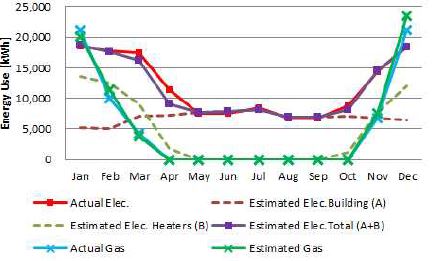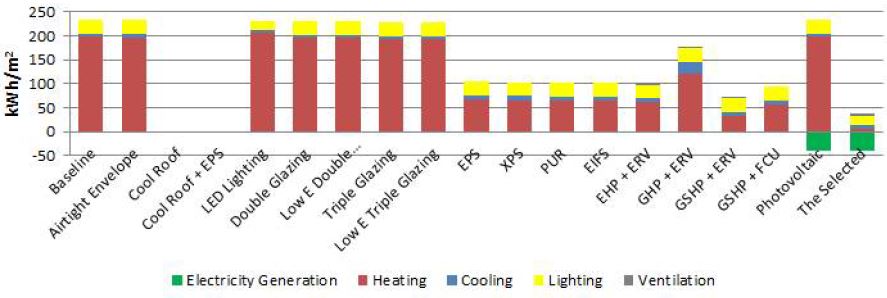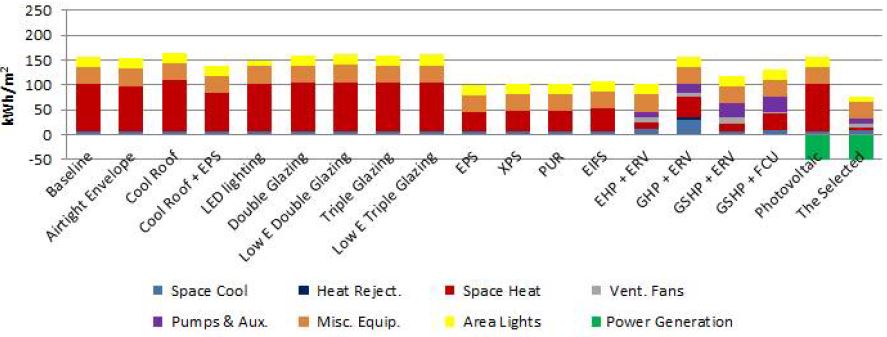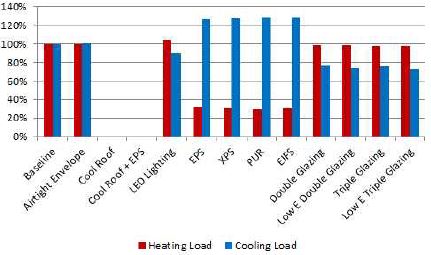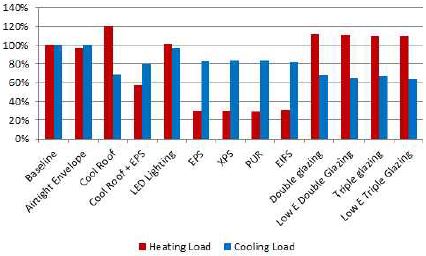
Selection of Energy Conservation Measures for Building Energy Retrofit: a Comparison between Quasi-steady State and Dynamic Simulations in the Hands of Users
ⓒCopyright Korea Institute of Ecological Architecture and Environment
Abstract
Quasi-steady state simulations have played a pivoting role to expand the user group of simulation to design engineers and architects in Korea. Initially they are introduced in the market as a building energy performance rating tool. In domestic practice, however, quasi-steady state simulations seem to be regarded as a de facto simulation only available for energy retrofit. Selection of ECMs and economic feasibility analysis are being decided through these tools, which implies that running these tools has become a norm step of the Investment-grade Audit.
This study aims at identifying issues and problems with the current practice via test cases, analyzing the reasons and opportunities, and then eventually suggesting proper uses of quasi-steady state and dynamic simulations.
The functionality of quasi-steady state simulations is more optimized to the rating. If they are to used for energy retrofits, their off-the-shelf functions also need to be expanded for customization and detailed reports. Yet their roles may be limited only to the go/no go decision; because their algorithms are still weak at precisely estimating energy and load savings that are required for making investment decisions compared to detailed simulations.
Keywords:
Green remodeling, ESCO, Energy retrofit, Energy conservation measure, ECO2, Quasi-steady state, Simulation1. Introduction
Reconstruction vs. retrofit. Forty years from the era of new development in 70’s leaves the choice to us. Remaining old buildings that cannot afford reconstruction expenses are concerned with a carbon crisis, because existing buildings compose almost all domestic buildings that use almost 30% of national energy. In fact, it is a global demand to reduce energy consumption of domestic existing buildings in lieu of decreasing global carbon emission. National agencies begin to promote energy retrofits for private buildings by means of offering incentives, rebates, or tax exemption. It is because owners of old buildings are not willing to choose the energy retrofit, if initial investment gives a burden to them.
ESCO (Energy Service COmpany) and green remodeling are business models of the energy retrofit. To make more investors engaged who are afraid of a large initial capital cost and a risk of project failure, energy retrofit contractors have suggested ESPCs (Energy Savings Performance Contracts), a contract in which the contractor provides and finances ECMs (Energy Conservation Measures) and is repaid from the saved energy costs. The contractor then does need a guarantee that improvements will generate energy cost savings sufficient to pay for the project over the contract term.
To compose a rational investment and to hedge a risk and responsibility in case of failures, three stake holders of the building energy retrofit project- owner, contractor, national agency- do need a credible measure that ensures a fair communication and assessment in selecting ECMs qualified for a subsidy, and determining reasonable size and duration of investment, and payback. Additionally to the owners, most of whom are non-experts, the measure has to be objective and certified by professionals on behalf of them.
Since building energy simulation is capable of taking the above mentioned roles and has been already used for rating the energy performance of a building, national agencies have first suggest the simulations as the measure for retrofit projects. Then contractors and finally owners also agree upon it. Initially dynamic simulations are only available building energy simulations in the market. Due to a low usability and too much required inputs for them, quasi-steady state simulations that are simple, normative, transparent, and requiring less inputs have been developed especially for a rating purpose.
2. Decision making for ESCO and green remodeling
2.1. Process of ESCO and green remodeling
Figure 1 lays out the typical process and activities necessary for ESCO and green remodeling projects. The pre-planning phase starts with comparing actual energy use of the target building to peers in national benchmarks to identify an apparent potential for energy improvements, and to decide whether further evaluation is warranted. If it is still worthy to proceed, a preliminary energy audit, which can be accomplished with a walk-through in one to two days, is conducted to identify potential energy savings at a very high level. This first audit provides sufficient information to assess the project goals, and also clarifies a realistic range of the required capital investment. Since the project reaches this step with little or no investment, the go or no-go decision is made referring to high-level ECMs and estimates of both energy and associated cost savings. If the owner decides to move forward, the project continues with the IGA (Investment-grade Audit). It requires much more detailed and intensive data, typically conducted in even two-three months beyond the preliminary audit [1]. Also it provides the baseline of M&V (Measurement and Verification) as well as a technical basis for judging whether the project should be on ESPCs or not. Lastly the project proposal containing the final candidate ECMs, and saving calculations and financial analyses in much more accurate and greater detail giving the confidence to the investor are suggested.
2.2. Roles of building energy simulations in audits
Both the preliminary energy audit and IGA obviously work better with higher resolution energy data such as sub-metered energy end uses. Both audits analyze what energy end use and systems consume excessive energy compared to the benchmark, and then suggest ECMs that enhance an efficiency and effectiveness of those weak parts, although details can be varied upon.
Unfortunately a majority of small and mid-sized old buildings in Korea is not equipped with sub-metering and data logging; it is an often case that monthly utility bills are only available energy data - the worst case is a combined utility bill for a building block which consists of multiple and various types of buildings.
Building energy simulations have been used as a harness to factorize the whole building energy use into energy breakdowns. It is doable even with high-level building features that are obtainable through one to two day audits, and monthly energy use per building.
In contrast to new building designs, building energy retrofits start from case-by-case standings. Building energy simulation, therefore, should take in site-specific inputs, and then its resulting energy use should be compared to actual energy use. Finally inputs should be modified, if the difference is larger than a certain tolerance. This calibrated simulation is then called the baseline; ECMs are selected by evaluating their expected energy savings with respect to the baseline. Additionally actual energy savings of the installed ECMs can be verified with the normalized baseline.
Although calibration is a very essential procedure for building energy retrofit, without mentioning a difficulty of collecting “good” data, calibration is not always feasible with quasi-steady state simulations in the hands of users. Since quasi-steady state simulations aim at offering a rapid assessment of energy performance of a building to non-expert users, most quasi-steady state simulations have been shipped off in a proprietary software package supporting more user-friendly interfaces. However, it means that customizing inputs fitted for user’s situation is not allowed, and running an input on the simulation engine alone separatedly from the user interface is not allowed, either; whereas most off-the-shelf dynamic simulations support both customization and independent runs on the stand-alone simulation engine.
2.3. Retrofit decision makings using simulations in literature and practice
In literature both quasi-steady state and dynamics simulations are used for the basis for both the go/no go decision in the pre-planning phase, and the project proposal in the planning phase.
Dynamic simulations including DOE-2 and EnergyPlus are primary contributors that have launched the Option D-Calibrated Simulation [2]. Although it is known working more effectively with detailed building energy information usually collected through the IGA, third-party tools using dynamic simulations as pre-simulations [3] or those with BIM and simplified user inputs (also with a number of in-house defaults) [4] argue their usefulness at the very beginning phase of the retrofit project.
Reversely, quasi-steady state simulations are known working more efficiently with basic energy data collected through a simple walk-through audit. They are notably refereed as rapid energy analysis tools optimized at an early decision phase of the retrofit project. More frequently than not, they are used to the ASHRAE level 3 audit [5], but their applications are limited; their algorithms are limited in analyzing transient thermal phenomena and complex interactions between components.
In domestic practice, however, quasi-steady state simulations seem to be regarded as the only building energy simulation available for building energy retrofit. Eventually it is because national agencies choose the quasi-steady state simulation to assess energy ratings of existing buildings, and then ask for confirming an upgrade in the rating, if owners want a financial subsidy for ESCO or green remodeling.
2.4. Objectives of the study
In the domestic market, the ECO2, a packaged quasi-steady state simulation, and sibling tools have been perceived as de facto building energy simulations for diagnosing energy performance of existing buildings. Selection of ECMs and economic feasibility analysis are being decided through these tools, which implies that running these tools has become a norm step of the IGA.
This study aims at identifying issues and problems with the current practice via test cases, analyzing the reasons and opportunities, and then eventually suggesting proper uses of both types of simulations. The DOE-2 is compared to the ECO2, because it is one of the mostly used dynamic simulations for LEED energy ratings in the U.S. and also it is shipped in an off-the-shelf package called eQUEST. The comparisons are tested in an actual building in the Seoul Tech campus.
3. Test case
3.1. Description of test building
The test building is a two-story school building having class rooms, labs, offices and common areas. It was initially constructed around 50 years ago and there is no written records of historical states of construction and systems, or retrofit details. It uses campus steam for heating via radiators, but no submetering is available. It should be noted that their heating capacity is not sufficient, in that they are turned on during only a few hours in winter days and even triggered by outdoor air temperature, not by occupants’ needs. Package air conditioners provide cooling. Only monthly electrical consumption is available. Monthly gas consumption has to be estimated based on radiator capacity, operating hours, and estimated thermal loss from the block gas use.
3.2. Preparation of baseline models
Since no document is available except for plans and radiator plumbing drawings, critical energy attributes of the test building are collected as listed in Table 1. Modeling of building geometry, orientation, and structure & construction refer to the plans. Unfortunately it is not possible to measure U-value of SOG (Slab On Ground) and air change rate; instead they are set to 1.82 W/Km2 and ACH 1.0, respectively. Heating and cooling setpoint temperatures are set to 22.2 and 24 °C, respectively. Other attributes such as material roughness & color, construction of interior walls and floors are set referring to the DOE-2 defaults.
Most occupants use electric heaters for auxiliary heating. The DOE-2 and ECO2, however, do not allow both radiators and electric heaters for the same zone. For the DOE2 baseline, heater electricity consumption is estimated under an assumption that occupants turn on electric heaters when indoor air temperature is lower than 21°C. This workaround, however, is not possible with the ECO2 due to an unavailability of hourly reports.
3.3. Diagnostics of the baseline models
The DOE-2 baseline including heater electricity consumption has been calibrated and then the DOE-2 outputs are compared to actual energy uses, as shown in Figure 2. The ECO2 baseline, however, could not be calibrated because it uses in-house values for weather, building usage profiles, and EPD (Equipment Power Density). Also it only displays annual energy uses, thus comparing the ECO2 output to actual monthly energy uses to find out “calibratable” input variables is not feasible.
Table 2 shows EUIs (Energy Use Intensity2)) of the two baselines. A site EUI of the ECO2 baseline is around 50% more than that of the DOE-2 baseline, meanwhile equipment energy use is not included in the ECO2 results. Heating energy use of the ECO2 baseline, which is almost double that of the DOE-2 baseline, clearly drives this discrepancy. Initially heating capacity of steam radiators has been designed far insufficient to meet the heating demand. Even if they operate at full loads, their gas use should be much lower than the expected gas use that ensures thermal comfort. While this specularity is deliberately captured in the DOE-2, it is not allowed in the ECO2.
3.4. Selection of ECMs and application
Excessive heating energy use is apparently due to the poor envelope; the test building has no insulation in walls and roof, single pane windows, and severe drafts.
Passive ECMs specifically enhancing envelope performance are chosen as listed in Table 3. Cool roofs and LED lighting, which are known to increase heating loads, are intensionally included, because occupants in the 2nd floor complain of hot indoor climate in summer seasons.
A variety types of heat pumps are chosen as active ECMs as listed in Table 4. Heat pump is a popular school retrofit measure for its installation portability, a quick response against variable loads, and easy maintenance. To diversify primary energy sources, gas engine and geothermal heat pumps are included. Photovoltaic panels are intensionally chosen to reduce electricity peaks. For sizing heat pumps, ground heat exchangers, and auxiliary pumps&fans, the RTS-SAREK [7] and the GLD [8] are employed.
All ECMs use commercial products and specifications that are commonly applied in domestic retrofit market. Construction documents such as shop drawings, and product catalogs such as system performance curves are collected for applying ECMs to the baseline. ECO2, however, does not allow speculating the reflectivity of construction material, which is the only way of modeling cool roof. Also it does not allow for speculating performance curves of heat pumps and FCUs.
3.5. Evaluation of ECMs in the two models
ECMs applied to the ECO2 baseline and the DOE-2 baseline are evaluated in Figure 3 and 4. For each baseline, ECMs mostly reducing the EUI in envelope insulation, window glazing, lighting power, equipment power, HVAC, and power generation, respectively, are chosen as follows. A set of {PUR, Airtight envelope, Low E triple glazing, LED lighting, GSHP+ERV, PV} is finally selected ECMs using the ECO2 baseline. Eventually the selected ECMs make the test building a “Net zero building” resulting in an EUI of –0.9 kWh/m2 vs. the ECO2 baseline EUI of 234.2 kWh/m2.
Meanwhile the selected ECMs using the DOE-2 baseline include {EPS, Airtight envelope, Double glazing, LED lighting, EHP+ERV, PV}. As expected, the cool roof by itself increases the total energy use due to increased heating load. However, the cool roof insulated with EPS reduces the total, because it reduces both heating and cooling loads. Since cool roof and PV cannot be installed simultaneously on the roof, PV is eventually included to the selected ECMs. The selected ECMs make the test building consuming an EUI of only 27.1 kWh/m2 vs. the DOE-2 baseline EUI of 155.2 kWh/m2.
A notable observation shown in Figure 3 and 4 is that energy saving ratios in the ECO2 are regularly larger than those in the DOE2 (except for photovoltaic). It is more visible in insulations and heat pumps. This highlights that as the ECO2 can result in a more drastic energy savings than the DOE-2, ECMs should be selected with a certain safety factor when the ECO2 is a single evaluator.
4. Analysis for further decision situations
During the preliminary energy audit and IGA, different questions in an attempt of selecting ECMs and feasibility analysis can be asked as follows, then a choice of ECMs can be varied in two simulations.
Case 1: is the baseline significantly accurate and precise compared to actual energy use?
The DOE-2 baseline has been calibrated against actual electricity and gas consumption. The ECO2 baseline, however, has not been calibrated with a sufficient degree of accuracy and precision due to the reasons in Section 3.3.
Case 2: does this building need energy retrofits?
While the source EUI of 320.2 kWh/m2 by the ECO2 corresponds to the 3rd grade of the Building Energy Efficiency Certification [9], the source EUI of 177.5 kWh/m2 by the DOE-2 (with the equipment EUI excluded) corresponds to the 1st plus grade, which implies that the test building may not need an energy retrofit.
Case 3: what ECMs can achieve at least 30% of the energy savings?
Single ECMs achieving more then 30% savings do not much differ from each other as shown in Table 5. A combination of ECMs ranging from 10 to 30% savings, however, can be a very different choice to each other simulation.
Case 4: which ECM is the most cost effective?
The GSHP+ERV and EPS are analyzed to achieve the largest energy savings with 68% in the ECO2 and 36% in the DOE-2, respectively. Secondly, the EHP+ERV and insulations can achieve avg. 55% savings in the ECO2, while the other insulations, EHP+ERV, and photovoltaic can achieve avg. 34% savings in the DOE-2. Considering a large capital cost of GSHP (due to ground heat exchangers) and insulation works, the EHP+ERV, the intersection between two analyses, seems to be the most cost effective ECM.
Case 5: can the insulated envelope and high performance glazing significantly reduce the heating and cooling loads in order to design smaller HVAC systems?
Although insulations increase the cooling load in the ECO2 as shown in Figure 5, they reduce both loads in the DOE-2 as shown in Figure 6. The DOE-2 building component report has confirmed the reduced heat gain and loss through the envelope.
While high performance glazing reduce only the cooling load in the ECO2 (Figure 5), it increases the heating load and also simultaneously reduces the cooling load in the DOE-2 (Figure 6). The DOE-2 building component report has confirmed the reduced SHGC of high performance glazing makes solar heat gains lower in both winter and summer seasons.
Case 6: which insulation and glazing are cost effective?
Both envelope insulation and high performance glazing reduce the EUI in the ECO2 (Figure 3), whereas high performance glazing slightly increases the EUI while insulations reduce it in the DOE-2 (Figure 4). It is because a lower SHGC of the high performance glazing reduces the solar heat gain and thus increases the heating load.
Ranges of energy saving ratio do not differ from each other in both insulation and glazing types. Therefore the cheapest ones, the EPS and the double glazing, seem to be cost-effective envelope ECMs.
Case 7: is the insulated envelope preferred over high performance glazing?
Accounting for the answers of Case 5 and 6, insulations seem to be an effective envelope ECM. High performance glazing looks acceptable in the ECO2 regardless of only 2 to 3 % energy saving. The SHGC of the glazing, however, definitely needs to be adjusted according to the DOE-2 analysis. It further incurs a design optimization problem between U-value and SHGC per orientation in order to reduce both heating and cooling loads.
Case 8: is the EIFS preferred over any interior insulations?
The EIFS shows achieving almost similar savings with interior insulations in the ECO2, whereas it results in around 6% less savings than the EPS in the DOE-2. Although the EIFS is superior to interior insulations in preventing thermal bridge and condensation, it should be carefully chosen in terms of both capital and energy cost benefits.
Case 9: is the cool roof still an inadequate ECM to this building?
Energy performance of the cool roof cannot be assess through the ECO2. The DOE-2 analyzes that the cool roof only can incur an excessive heating load, but the EPS insulated cool roof can be an effective envelope ECM.
Case 10: is the geothermal heat pump preferred over the air source heat pump?
In the ECO2, energy savings by GSHPs are analyzed larger than that by the EHP-ERV. In the DOE-2, reversely, it is analyzed that GSHPs consume significantly less energy in heating, but does consume a significant amount of energy for operating circulation pumps.
Case 11: is the photovoltaic a universal ECM for a zero energy building?
As shown in Figure 3 and 4, the photovoltaic ensures at least 15% energy savings compared to the baselines. The DOE-2, however, overestimates its savings up to 35%. Due to this variability, the photovoltaic is recommended as the final ECM that confirms a net zero, rather than the first ECM.
The forementioned cases warn us that only relying on the ECO2 to make critical decisions of the ESCO and green remodeling can result in a wrong lineup of ECMs or even cause project failures. An example of the former is that insulation and high performance glazing ECMs in some situations (such as Case 5) may not be selected because they are not qualified for the rebate awarded upon building load saving ratios, even if they actually reduce it. In particular for financial decisions made for the ESPC such as payback years, the ECO2 does not look adequate at all to assess the expected energy cost savings by ECMs in terms of a desired level of accuracy.
However, a number of cases that quasi-steady state simulations are used as a decision making basis for building energy retrofit have been reported in literature. If quasi-steady state simulations in a proprietary package allow customization (such as weather, building usage profiles and EPD) and detailed intermediate and final analyses (such as hourly building load and component reports) to take all the merits and advantages of their functionalities, they can offer investors more room to contemplate an economic feasibility on which a success or failure of the project depends, although it may introduce some complexity.
5. Conclusion
Quasi-steady state simulations have played a pivoting role to expand the user group of simulation to design engineers and architects in Korea. As they are introduced as a rating tool in the market, however, their functionalities are more optimized to it. If they are to used for building energy retrofits beyond their predefined calling, their off-the-shelf functions also need to be expanded for customization and detailed reports.
Yet their roles may be limited only to the go/no go decision; because their algorithms are still weak at precisely estimating energy and load savings required for making investment decisions compared to detailed simulations.
Quasi-steady state simulations in the hands of users are quick and convenient. It is certainly a merit for rating new building designs, but can be an indigestion for making retrofit investment decisions. Indeed a rational decision maker will choose an accurate assessment although its process is a bit complex and takes a bit longer, rather than a blunt assessment made in a minute.
Acknowledgments
This study was supported by the Research Program funded by the Seoul National University of Science and Technology.
Notes
References
- Sanders, M. D., (2014), , Ready to Retrofit: The Process of Project Team Selection, Building Benchmarking, and Financing Commercial Building Energy Retrofit Projects.
- DOE, (2015), M&V Guidelines: Measurement and Verification for Performance-based Contracts. Version 4.0.
- Lawrence Berkeley National Laboratory, (2013), EnergyIQ, http://energyiq.lbl.gov.
- Autodesk, (2016), Autodesk Green Building Studio, http://gbs.autodesk.com.
- Gaasch, W. H., Travis, J., Zhao, F., Kaplan, M., & Muth, C., (2014), A Comparison of Methods for Early-Stage Retrofit Analyses.
- EPA, (2016), The difference between source and site. energy, https://www.energystar.gov/buildings/facility-owners-and-managers/existing-buildings/use-portfolio-manager/understand-metrics/difference.
- SAREK, (2016), RTS-SAREK, https://www.dcs.co.kr/product/product_introduce.php?product=sarek.
- Thermal dynamics, (2016), Ground Loop Design, http://www.groundloopdesign.com.
- KEMCO, (2016), The Building Energy Efficiency Certification, http://www.kemco.or.kr/building/v2/buil_cert/buil_cert_1_5.asp.


